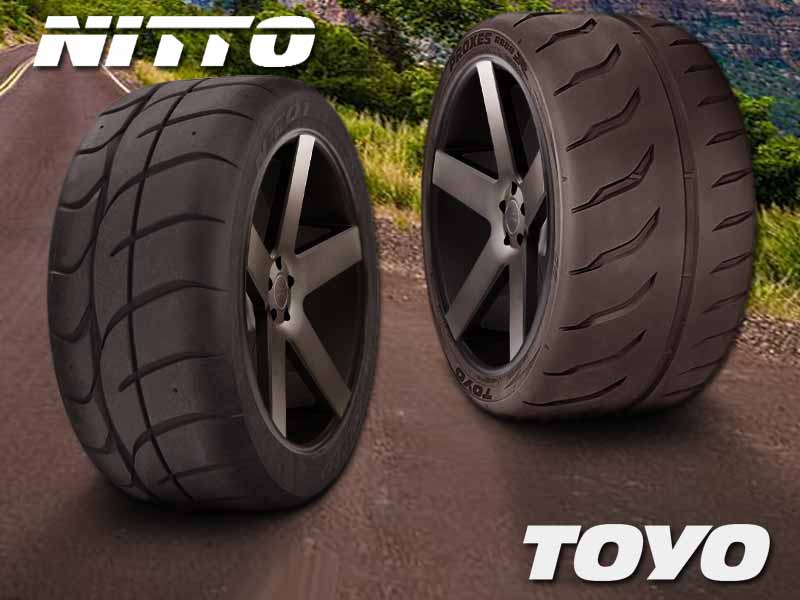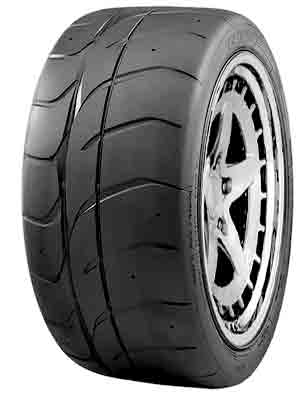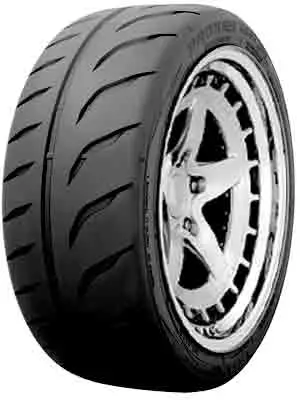Both Nitto NT01 and Toyo Proxes R888R with asymmetric tread patterns are extreme-performance summer competition and track day tires designed for sedans, sporty coupes, and passenger cars. Both contenders are DOT complaints which means they comply with the U.S Department of Transformation.
Nitto NT01 is a combo of specialized race compounds and body-ply constructional features. Its steel-reinforced sidewalls and high modulus rayon carcass provide better heat cycle performance and consistency along with these features; superior grip and handling on wet pavements, fuel efficiency with better hydroplaning resistivity.

Toyo Proxes R888R is an evolutionary tire because it has improved features from its legendary predecessor Toyo R888. These features include high-grip racing compounds and improved tread design. And it has a unique internal structure of rayon casing supported by high-tensile steel belts and spirally-wound nylon reinforcing plies. Which are providing advanced durability plus enhanced high-speed stability over grip and handling on drier pavements. Finally, it also produces less noise as compared to its competitor.
Where both contenders are tied in the comfort, durability, and limited standard warranty segments, NT01 is expensive with superior features of enhanced fuel efficiency and better aquaplaning resistivity. But lacks behind its competitor when it comes to dry traction, load enduring capability, speed rating, noise production, and cost.
Table of Contents
Side By Side Comparison
Nitto NT01

Toyo R888R

| Specifications | Nitto NT01 | Toyo R888R |
| Tire type | Competition and track day | Competition and track day |
| Tire season | Summer | Summer |
| Tread type | Asymmetrical | Asymmetrical |
| Available sizes, inches | 14, 15, 16, 17, 18, 19, 20 | 13, 14, 15, 16, 17, 18, 19, 20 |
| Application | Sedans & Sporty Coupes | Sedans & Sporty Coupes |
| Standard limited warranty | 5 years | 5 years |
| UTQG rating | 100 AA A | 100 AA A |
| Cost (245/40R18) | 306 $ | 268.09 $ |
Tread Design
NT01 has an asymmetrical tread pattern with two circumferential grooves and one central rib. There are lateral grooves on shoulder blocks and the central rib. There are also some notches on the central rib. Its circumferential grooves are of varied width so its contact patch would be considered inconsistent. Overall, its contact patch is lesser than its competitor. Its outer and inner shoulder blocks are also narrower than its competitor. Finally, there are no sipes all over the length of the tire.
Like its competitor, Toyo R888R also has an asymmetrical tread pattern but it has only one central circumferential groove. There are some notches on its outer and inner shoulder blocks. There are no ribs, lateral grooves, and sipes all over the length of the tire. It has a consistent contact patch because its single circumferential groove has uniform width and depth. And overall, its contact patch is more than its competitor. Similarly, its outer and inner shoulder blocks are also wider than its competitor.
Road Grip
NT01 would provide inferior road grip on dry pavements because its overall contact patch is lesser than its competitor. And its grip performance on wet roads would not be good as well, since there are no sipes on it.
Whereas Toyo R888R would provide superior road grip on dry pavements because its overall contact patch is more than its opponent. Like its competitor, it also doesn’t have any sipes on it which would become the reason for its poor grip on wet pavements.
| Parameters | NT01 | R888R |
| Dry Grip | Moderate | High |
| Wet Grip | Low | Low |
Road Handling
NT01 would provide inferior road handling on dry pavements because it has comparatively smaller shoulder blocks than its competitor. Its wet handling would also be pretty bad since there are no sipes on the edges as well.
Similarly, R88R would give a superior road handling facility on dry pavements because its outer and inner shoulder blocks are comparatively larger. Like its competitor, its wet handling would also be inadequate due to having no siping pattern on it whatsoever.
| Parameters | NT01 | R888R |
| Dry Handling | Moderate | High |
| Wet Handling | Low | Low |
Hydroplaning Resistivity
During the rainy season or extreme water flow on the road, the hydroplaning resistivity of NT01 would be superior since it has more circumferential grooves, notches, and lateral grooves on it which would increase its overall void ratio. On the other hand, R888R has only one circumferential groove and wide notches on it which would provide pretty decent hydroplaning resistivity but still, it would be inferior to its competitor.
Durability and Tread Wear
Durability and tread wear sectors are analyzed with the data of one prospect; tread depth.
| Contenders | Tread Depth |
| NT01 (245/40R18) | 6.3/32″ |
| R888T (245/40R18) | 6.3/32″ |
Since both contenders have the same tread depths and their construction material is also on equivalent stage which includes reinforced steel walls, rayon casing, and body-ply construction. So, from the durability perspective, both contenders would perform equally well.
Comfort and Noise
Both contenders will also be tied in the comfort factor because both have the same tread depths. Tread depths are meant for providing cushions on bumpy roads and irregular tracks.
The noise factor is mainly analyzed with the void ratio of the tires. Having a more void ratio would allow more air to get encapsulated at high-speed driving. This would call humming sound due to the collision of air particles with the tread wall inside the grooves. So, the Toyo R888R would have less noise than its competitor because it has a comparatively less void ratio.
Rolling Resistance and Fuel Efficiency
Rolling resistance is a stopping force for tires due to friction between a tire and the road. It is responsible for the fuel-efficiency parameter of tires. So whichever tire has less contact patch will have less rolling resistance and hence it would be more fuel-efficient.
Considering all this reasoning we can conclude that NT01 will be more fuel-efficient because it possesses less contact patch than its competitor.
Load and Speed
The speed ratings and load indexes of both contenders is being shown in the table given below.
| Contenders | Speed Rating | Max Speed (mph) | Load Index | Max Load (lbs.) |
| NT01 | W | 168 | 93 | 1433 |
| Toyo R888R | Y | 186 | 97 | 1609 |
Looking at that data table we can easily conclude that the Toyo R888R is the winner in both categories since its maximum speed and maximum load capacity is relatively higher than its competitor.
Price
NT01 is costlier than its competitor due to having these factors; better hydroplaning resistivity and enhanced fuel efficiency. But it looks unjustifiable because its competitor Toyo R888R at a lower cost is comparatively providing more features like; providing superior grip and handling on dry pavements, producing less noise, enduring heavier loads, and reaching higher speeds. Prices of NT01 and Toyo R888R are 306$ and 268.09$ respectively.
Quick Summary
Both contenders;
- Have asymmetrical tread patterns.
- Are competition and track tires designed for the summer season.
- Provide a comfortable ride.
- Have poor grip and handling on wet surfaces.
- Would be equally durable.
NT01;
- Has better hydroplaning resistivity.
- Is a more fuel-efficient tire.
Toyo R888T;
- Has superior grip and handling on dry pavements.
- Produces comparatively less noise.
- Can endure heavier loads with exceeding speeds.
- Is relatively cheaper.


